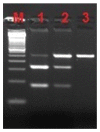Relation between Endothelial Nitric Oxide Synthase Genotypes and Oxidative Stress Markers in Larynx Cancer
- PMID: 26682008
- PMCID: PMC4670686
- DOI: 10.1155/2016/4985063
Relation between Endothelial Nitric Oxide Synthase Genotypes and Oxidative Stress Markers in Larynx Cancer
Abstract
Nitric oxide synthase (eNOS/NOS3) is responsible for the endothelial synthesis of nitric oxide (NO(•)). G894T polymorphism leads to the amino acid substitution from Glu298Asp that causes lower NOS3 activity and basal NO(•) production in NOS3 894T (298Asp) allele carriers compared with the GG homozygotes. NO(•) acts as an antioxidant protecting against Fenton's reaction which generates highly reactive hydroxyl radicals. Allelic variation of NOS3 may influence an individual's risk of laryngeal cancer (LC). In the current study we have examined the possible relationship between NOS3 G894T genotypes and various systemic oxidative damage markers such as protein carbonyl, advanced oxidation protein products, Cu, Zn-superoxide dismutase, thiol group fractions, and lipid hydroperoxides in LC patients. Genotyping was carried out by PCR-RFLP. In LC patients with TT genotype, Cu, Zn-superoxide dismutase activities and nonprotein thiol levels were significantly higher than the controls. In patients with GT and GG genotype, high levels of lipid hydroperoxides showed statistical significance when compared to controls. Our results indicate a potential relationship among G894T polymorphism of NOS3, and impaired redox homeostasis. Further studies are required to determine the role of NOS3 gene polymorphism and impaired plasma redox homeostasis.
Figures

Similar articles
-
Endothelial nitric oxide synthase gene Glu298Asp polymorphism is associated with advanced stage endometriosis.Hum Reprod. 2009 Oct;24(10):2656-9. doi: 10.1093/humrep/dep212. Epub 2009 Jun 16. Hum Reprod. 2009. PMID: 19531501
-
Functional G894T (rs1799983) polymorphism and intron-4 VNTR variant of nitric oxide synthase (NOS3) gene are susceptibility biomarkers of obesity among Tunisians.Obes Res Clin Pract. 2016 Jul-Aug;10(4):465-75. doi: 10.1016/j.orcp.2015.04.008. Epub 2015 May 5. Obes Res Clin Pract. 2016. PMID: 25956856
-
Association of endothelial nitric oxide synthase gene G894T polymorphism with blood oxygen transport.Nitric Oxide. 2019 Mar 1;84:45-49. doi: 10.1016/j.niox.2019.01.007. Epub 2019 Jan 11. Nitric Oxide. 2019. PMID: 30641122
-
G894T and 4a/b polymorphisms of NOS3 gene are not associated with cancer risk: a meta-analysis.Asian Pac J Cancer Prev. 2015;16(7):2929-37. doi: 10.7314/apjcp.2015.16.7.2929. Asian Pac J Cancer Prev. 2015. PMID: 25854385
-
[Research Progress of NOS3 Participation in Regulatory Mechanisms of Cardiovascular Diseases].Sheng Wu Yi Xue Gong Cheng Xue Za Zhi. 2016 Feb;33(1):188-92. Sheng Wu Yi Xue Gong Cheng Xue Za Zhi. 2016. PMID: 27382763 Review. Chinese.
Cited by
-
Hydrogen peroxide-induced mitophagy contributes to laryngeal cancer cells survival via the upregulation of FUNDC1.Clin Transl Oncol. 2019 May;21(5):596-606. doi: 10.1007/s12094-018-1958-5. Epub 2018 Oct 3. Clin Transl Oncol. 2019. PMID: 30284230
-
Network pharmacology reveals the potential mechanism of Baiying Qinghou decoction in treating laryngeal squamous cell carcinoma.Aging (Albany NY). 2021 Dec 20;13(24):26003-26021. doi: 10.18632/aging.203786. Epub 2021 Dec 20. Aging (Albany NY). 2021. PMID: 34986125 Free PMC article.
-
Gasotransmitters in the tumor microenvironment: Impacts on cancer chemotherapy (Review).Mol Med Rep. 2022 Jul;26(1):233. doi: 10.3892/mmr.2022.12749. Epub 2022 May 26. Mol Med Rep. 2022. PMID: 35616143 Free PMC article. Review.
-
Variability in oxidative stress-related genes (SOD2, CAT, GPX1, GSTP1, NOS3, NFE2L2, and UCP2) and susceptibility to migraine clinical phenotypes and features.Front Neurol. 2023 Jan 9;13:1054333. doi: 10.3389/fneur.2022.1054333. eCollection 2022. Front Neurol. 2023. PMID: 36698892 Free PMC article.
-
Renalase as a Novel Biomarker for Evaluating the Severity of Hepatic Ischemia-Reperfusion Injury.Oxid Med Cell Longev. 2016;2016:3178562. doi: 10.1155/2016/3178562. Epub 2016 Oct 27. Oxid Med Cell Longev. 2016. PMID: 27867452 Free PMC article.
References
Publication types
MeSH terms
Substances
LinkOut - more resources
Full Text Sources
Other Literature Sources
Miscellaneous

